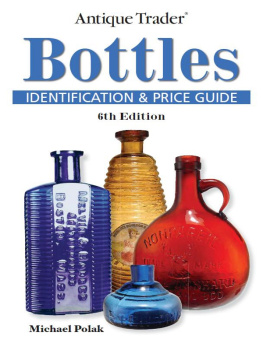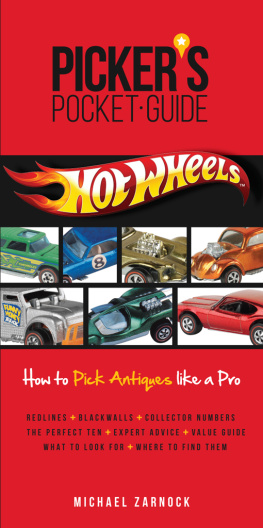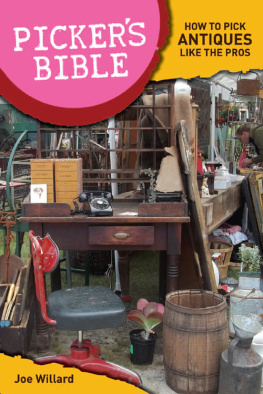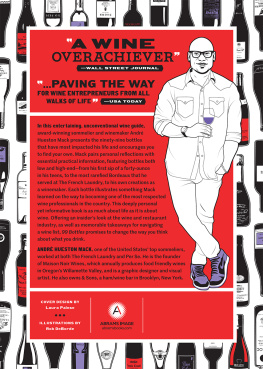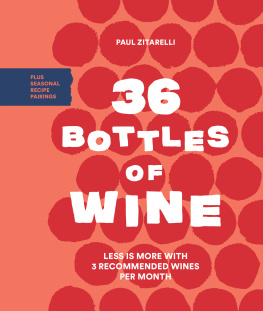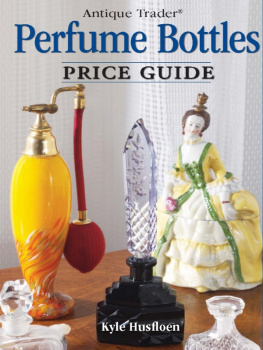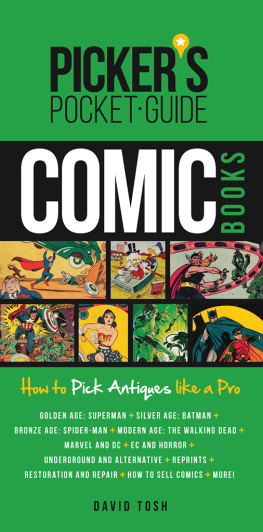Contents
Guide
PICKERS
POCKET GUIDE
BOTTLES
How to Pick Antiques like a Pro
MICHAEL POLAK
CONTENTS
Introduction
Welcome to the fun hobby of antique bottle collecting with the exciting new edition of the Pickers Pocket Guide: Bottles.
I thank all my readers for their support in making the Antique TraderBottles Identification & Price Guide and WarmansBottles Field Guide such huge successes. With the publication of each edition of those books, the positive response continues to be overwhelming. Living up to the nickname The Bottle Bible given to Antique TraderBottles Identification & Price Guide, Ive incorporated this positive feedback into the new Pickers Pocket Guide: Bottles as well.
The idea behind this new book, while continuing to be a detailed and informative reference guide, is to feature an expanded Bottle Sources section, starting on titled Determining Bottle Values.
Overall, there are 17 chapters of bottlesincluding Bitters, Black Glass, Flasks, Fire Grenades, Soda, and Whiskeythat provide beginning and veteran pickers and collectors with a broad range of information and reference data. The book also includes extensive sections on the history and origin of glass and bottles; how a beginner gets started; bottle basics, bottle handling techniques, and other reference material. In addition to a number of valuable illustrations, this edition also features stunning color photographs throughout the book.
Interest in bottle collecting continues to grow, with new bottle clubs forming throughout the United States and Europe, and pickers will get tips on what bottles interest these collectors. More pickers, as well as collectors, are spending their free time digging through old dumps and foraging through ghost towns, digging out old outhouses (thats right), exploring abandoned mine shafts, and searching their favorite bottle or antiques shows, swap meets, flea markets, and garage sales. In addition, the Internet has greatly expanded, offering numerous opportunities and resources to buy and sell bottles with many new auction websites, without leaving the house. Many bottle clubs now have websites providing even more information for the collector. These new technologies and resources have helped the hobby of bottle collecting continue to grow and gain interest.
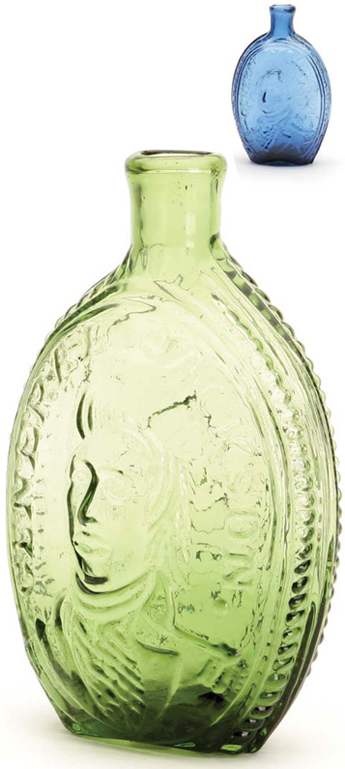
These extremely rare history flasks rocked the world of antique bottle collectors when they sold at auction for world-record prices. The sapphire blue General Washington firecracker flask, at right, sold for $101,620.
The yellow green General Jackson and Bust portrait flask, below, sold for $176,670. Another Washington flask also sold for a record price; see for more information.
Norm Heckler Auctions
Most collectors, however, still look beyond the type and value of a bottle into its origin and history. I find that researching the history of a bottle is almost as interesting a project as finding the bottle itself. I enjoy both pursuits for their close ties to the rich history of the settling of the United States and the early methods of merchandising.
My goal has always been to enhance the hobby of bottle collecting for both beginning and expert collectors and to help them experience the excitement of collecting, especially the thrill of making a special find. I hope this book brings you an increased understanding and enjoyment of the hobby of bottle collecting. Now, grab your copy of Pickers Pocket Guide: Bottles, toss it into your backpack, purse, or pocket, and check out some bottles.
To provide input regarding this first edition, to order books, or just talk about bottles, contact me at . Good bottle hunting and have fun with the hobby of bottle collecting.
Michael Polak
How to Use This Book
Pickers Pocket Guide: Bottles is formatted to assist all collectors and pickers, from the novice to the seasoned veteran, in finding elusive and hidden bottles. The table of contents indicates these sections such as Beginning Tips, that veterans may want to skip. However, other sections, including History and Origin, Bottle Basics, Bottle Sources, Bottle Handling, and Digging for Bottles, will provide additional valuable information and resources for the benefit of all.
The main section of the book including 17 chapters on various kinds of bottles covers old bottles manufactured almost exclusively before 1900, broken down into categories based on physical type and the bottles original contents. Where applicable, trade names are listed alphabetically within these sections. In some categories, such as flasks, trade names were not embossed on the bottles, so pieces are listed by embossing or other identification that appears on the bottle. Descriptive terms used to identify these pieces are explained in the introductory sections and are also listed in the glossary at the end of the book.
The reference and research sections, Trademark Identification, and Museum and Research Resource, provide additional assistance and help to all collectors and pickers.
History and Origin
Glass bottles are not as new as some people believe. In fact, the glass bottle has been around for about 3,000 years. During the 2nd century B.C., Roman glass was free-blown with metal blowpipes and shaped with tongs that were used to change the shape of the bottle or vessel. The finished item was then decorated with enameling and engraving. The Romans even get credit for originating what we think of today as the basic store bottle and early merchandising techniques.
In the late 1st century B.C., the Romans, with the assistance of glassworker craftsmen from Syria and Egypt, began making glass vials that local doctors and pharmacists used to dispense pills, healing powders and miscellaneous potions. The vials were three to four inches long and narrow. The majority of early bottles made after the Romans were sealed with a cork or a glass stopper, whereas Romans used a small stone rolled in tar as their stopper. The finished vials contained many impurities such as sand particles and bubbles because of the crude manufacturing process. The thickness of the glass and the crude finish, however, made Roman glass very resilient compared to the glass of later times, which accounts for the survival and good preservation of some Roman bottles as old as 2,500 years. The Roman glass techniques and manufacturing methods would eventually influence all of the European Art and Industrial complexes.
The first attempt to manufacture glass in America is thought to have taken place at the Jamestown settlement in Virginia around 1608 by the London Company. It is interesting to note that the majority of glass produced in Jamestown was earmarked for shipment back to England (due to its lack of resources) and not for the new settlements. As it turned out, the Jamestown glass house enterprise ended up a failure almost before it got started. The poor quality of glass produced and the small quantity simply couldnt support Englands needs.
While a second unsuccessful attempt (in lieu of pattern) was made in 1621, the first successful American glasshouse was opened in 1739 in New Jersey by Caspar Wistar, a brass button manufacturer who immigrated from Germany to Philadelphia in 1717. During a trip in Salem County, New Jersey, Wistar noticed the abundance of white sand along with the proximity of clay, wood and water transportation. He soon bought 2,000 acres of the heavily wooded land and made arrangements for experienced glass workers to come from Europe; the factory was completed in the fall of 1739.


